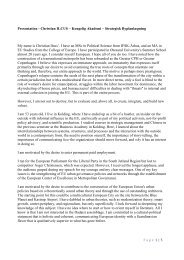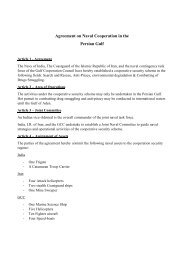china IR rev final sept 2023
This is the fourth and penultimate edition of my annotated bibliography on China international relations, art and Philosophy. from the books I distill policy relevant ideas for use and comsideration of policymakers after the ratification of the Cai, when the relatioship willl have to be managed
This is the fourth and penultimate edition of my annotated bibliography on China international relations, art and Philosophy. from the books I distill policy relevant ideas for use and comsideration of policymakers after the ratification of the Cai, when the relatioship willl have to be managed
Create successful ePaper yourself
Turn your PDF publications into a flip-book with our unique Google optimized e-Paper software.
International relations of China<br />
P.R. Kumaraswamy China and the Middle East. The Quest for Influence,<br />
Sage, 1999.<br />
China has evolved a complex Middle East policy, which is now integral to its great power aspirations. Comprising<br />
original contributions from a mixed bag of authors, this book examines China’s relations with key players in the Middle<br />
East and the impact of its Middle East policy on interactions with the USA and the UN, among others.<br />
Qiang Zhai China and the Vietnam Wars, 1950-1975, University of North<br />
Carolina UP, 2000.<br />
China has traditionally held to the view that it has vital interests vis-à-vis Korea and South-East-Asia, where it has<br />
sought a sphere of influence. Drawing on primary sources, Qiang Zhai examines China’s Indo<strong>china</strong> policy during the<br />
Cold War, depicting it as a rival of France and the United States, and explores the historical, domestic, and international<br />
context of the evolution of the relationship between Vietnam and China during the Cold War. Zhai provides essential<br />
insights into China’s conduct toward Vietnam and the ideological and geopolitical motives behind Mao Zedong’s<br />
foreign policy toward Vietnam. Permanent Chinese interest and threat perception vis-à-vis the United States during the<br />
1950’ies and subsequently concerns about Soviet inroads in South East Asia during the 1960’ies and 1970’ies, which<br />
led Mao to prod North Vietnam to conduct peace negotiations with the United States, which in turn contributed to the<br />
ping-pong diplomacy. From this, Kissinger drew inspiration and hatched a plan for triangular diplomacy between<br />
Beijing-Washington-Moscow to keep the two communist giants from coalescing and paved the ground for the opening<br />
up of China to the United States and subsequently to the world economy under a new Chine leadership. For a study on<br />
the recent evolution of Vietnamese foreign policy, consult Le Hong & Anton Tsvetov Vietnam’s Foreign Policy under<br />
Doi Moi.<br />
Yeo Lay Hwee ASEM. The Asia-Europe Meeting Process: From Sexy<br />
Summit to Strong Partnership ?, DUPI, 2002.<br />
ASEM is the official abb<strong>rev</strong>iation for the Asia-Europe Meeting – an informal forum and process for developing<br />
dialogue and cooperation between the two “old world” continents, Asia and Europe. One of ASSEM’s most noticeable<br />
peculiarities lies in the composition of its regional representation. The club members are characterized by all being on<br />
the economic growth trajectory. “ASEM is the result of various constellations of forces and interests. Explanations of its<br />
emergence can be explained by the main theoretical strands: the realist, liberal-institutionalist, and quasi-social<br />
constructivist. Each <strong>IR</strong> school explains different aspects of ASEM. The realists emphasize factors such as a systemic<br />
change in power distribution, the emergence of East Asia as an economic powerhouse, and the desire for an<br />
increasingly integrated EU to become a global actor in the emerging new world order. They also point to the<br />
convergence of narrow economic interest among the member states, the commercial race towards East Asia, and the<br />
newly developed Asian economy’s need to attract European capital and technology. All these forces combine to create<br />
the momentum behind the birth of ASEM. Liberal institutionalists, in turn, underline the rise in interest in regionalism<br />
and a trend toward inter-regional dialogue, and as an alternative to traditional bilateralism – which is seen as inadequate<br />
for coping with global problems – and to universalism – which is seen as hampered by the multiplicity and diversity of<br />
actors involved. Regionalism is a means to address challenges caused by globalization (read: an intensification of<br />
American-led businesses’ search for markets). ASEM, like APEC, is a means to an end: the management of complex<br />
interdependence. Constructivists, in turn, claim notably that East Asians are using ASEM to help speed up the process<br />
of regional identity-building through inter-regional interaction. They argue that regions and nations are social<br />
constructs, and identities and interests are not exogenously given but socially constructed. All these are created and<br />
recreated in the process of a global transformation. From this perspective, ASEM is essentially a result of various forces<br />
within Asia. Thus, Yeo Lay Hwee introduces his report commissioned by the Danish Institute of International Affairs.<br />
The research report covers the following themes: The genesis of ASEM: A Historical Overview, The Inner Workings of<br />
ASEM: Summits, Ministerial, and meetings. Facing reality: An empirical Assessment of ASEM. Into the Future:<br />
Challenges and Prospects. ASEM and Asia-Europe Relations after 9/11. This is a valuable volume laying out various<br />
explanations and uncovering the motives behind the creation of ASEM and how the theoretical optics influences our<br />
view of each other.<br />
Page 4 | 29








